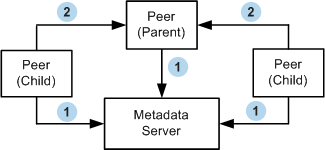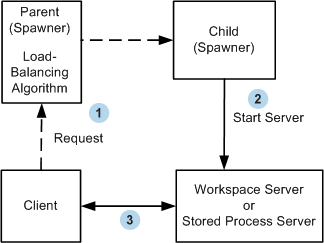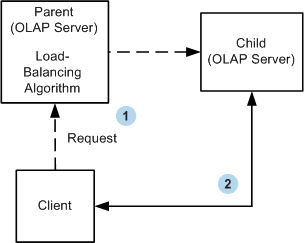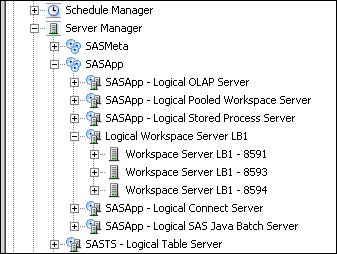Overview of Load Balancing
What Is Load Balancing?
Load balancing distributes SAS sessions
across a cluster of servers. You can add or subtract servers to accommodate
changes in peak demand.
You can create load-balancing
clusters of SAS Workspace Servers, SAS Stored Process Servers, SAS
Pooled Workspace Servers, and SAS OLAP Servers. For all clusters except
OLAP, load balancing is handled by the object spawners that are associated
with each server. SAS OLAP Servers do not use object spawners, so
OLAP servers handle load balancing directly.
Pooled workspace servers
are deployed in load-balancing clusters when you install them with
the SAS Deployment Wizard. You can create clusters of the other server
types at initial deployment, or at any time thereafter, without having
to restart your SAS Metadata Server.
Load-balancing clusters
use a peer-to-peer connection. One of the peers in the cluster acts
as the parent for the cluster.
Cluster Initialization

| 1 | Peers connect to and read configuration from the metadata server. |
| 2 | Peers attempt to connect to each other. One peer is designated to accept connections only from the other peers. This peer is known as the parent peer. Other peers are known as child peers. (Peers can be either object spawners or OLAP servers.) |
The parent peer runs
a load-balancing algorithm to determine the server that is best suited
to accept another client. When the parent receives a client request,
the parent either begins the session itself or redirects the client
to a specific child peer.
If a child peer receives
a connection request directly from a client, the child peer routes
the request to the parent peer for assignment to the server with the
least load.
The following
diagram depicts how clients are assigned to a server in the cluster
for workspace servers and stored process servers.
Client Assignment to Server (Workspace and Stored Process Servers)

| 1 | The parent receives a client request, applies it to its load-balancing algorithm, and redirects the client to connect to a specific peer. |
| 2 | In the case of a workspace server or a stored process server, the object spawner creates new server instance. |
| 3 | The client connects to that peer server. |
Client Assignment to Server (OLAP Servers)

| 1 | The parent receives a client request, applies it to its load-balancing algorithm, and redirects the client to connect to a specific peer. |
| 2 | The client connects to that peer server. |
During operation, if
the parent peer terminates, one of the child peers assumes the role
of parent peer. When you restart the former parent peer, it restarts
as a child peer instead of the parent peer. The new parent peer remains
the parent until that peer is restarted.
If a child peer terminates,
load balancing continues across the remaining peers. When a child
peer is restarted, the parent peer includes that peer in its routing
of client requests with no interruption of service.
When you add or remove
servers from a cluster, restart all of the peers (object spawners
and OLAP servers) in the cluster to ensure that all servers read the
latest metadata.
Overview of Planning, Installation, and Configuration
To create
a load-balancing cluster, you need to plan the configuration, create
server metadata, install server and spawner software, configure the
server software, and start the servers on their respective hosts.
In the planning stage,
you select an application server, a logical server, separate server
hosts, unique port numbers, a load-balancing algorithm, and server
login credentials.
In the metadata creation
stage, you use SAS Management Console to create metadata objects for
each server and spawner in the cluster. You then convert the servers
and spawners to load balancing.
In the server installation
and configuration stage, you use the SAS Deployment Wizard in Install
Only mode to install server software (without configuration files)
on host computers. For clusters of workspace servers, stored process
servers, and pooled workspace servers, you then use the SAS Deployment
Wizard to install a spawner on each host. (SAS OLAP Servers do not
use spawners.)
MultiBridge Connections (SAS Stored Process Servers Only)
When you configure load balancing for SAS Stored Process
Servers, you must define at least one MultiBridge connection for each
server in the cluster. A MultiBridge connection is a specialized bridge
connection that is used for stored process servers. Each MultiBridge
connection represents a separate server process and runs on a specific
port.
The bridge connection
for a stored process server is used only for the initial server request.
After the spawner determines which server process has the least load,
the client is redirected to the appropriate MultiBridge connection.
That is, a client requests the bridge connection for a stored process
server, and then the spawner redirects the client to the appropriate
MultiBridge connection.
Overview of the Initial Load Balancing Setup for Stored Process Servers
In the initial
load balancing SAS Stored Process Server configuration, three MultiBridge
connections are set up for the stored process server so that the object
spawner can start up to three stored process server processes. The
object spawner balances the work load across these processes. The
object spawner runs on the server host, listens for client requests,
and redirects clients to the appropriate server process.
The metadata server's
foundation repository contains the spawner, server, and security metadata
for the load balancing stored process server configuration. The object
spawner must connect to the metadata server, and the metadata must
be configured appropriately, in order for the spawner to start the
load balancing stored process server processes.
The object spawner obtains
the metadata that it needs to start a load balancing stored process
server as follows:
-
When the spawner is started, it reads a metadata configuration file named
metadataConfig.xmlthat contains information that is required to access the metadata server. This metadata configuration file specifies the following information:By default, themetadataConfig.xmlfile contains the user IDsastrust, which is owned by the SAS Trusted User (in the metadata).
When a client requests
a server, the client connects to the spawner and is authenticated
using the token that the client received when it connected to the
metadata server.
If the object spawner
needs to launch a new stored process server, then the object spawner
uses the server's multi-user login credentials (
sassrv)
to launch the load-balancing stored process server.
Note: Because the stored process
server runs under the multi-user login credentials that are specified
in the stored process server definition, each client can access information
that only
sassrv has permission to
access.
Security
Load-Balancing Algorithms
The
parent peer in a load-balancing cluster runs a load-balancing algorithm
to evaluate server load and select child peers for new SAS sessions.
Five algorithms are available: Cost, Response Time, Grid, Most Recently
Used, and Least Recently Used. SAS OLAP Servers are required to use
the Least Recently Used or the Grid algorithms. Other types of load-balancing
clusters enable you to select between two or more available algorithms.
Log Files
At installation, clustered servers are configured to
generate the same error log files that are generated by default on
servers that are not clustered, as described in the chapter “Administering
Logging for SAS Servers” in the SAS Intelligence Platform:
System Administration Guide.
Clusters
of SAS OLAP Servers, SAS DATA Step Batch Servers, and SAS/CONNECT
Servers generate separate ARM log files in addition to their error
log files. You should enable ARM logs only when you are tuning and
testing your clusters.
CAUTION:
To ensure
the accuracy of your ARM log files, be sure to configure your cluster
so that each server writes to a separate ARM log file.
Log files are configured
as described in Edit logconfig.xml.
